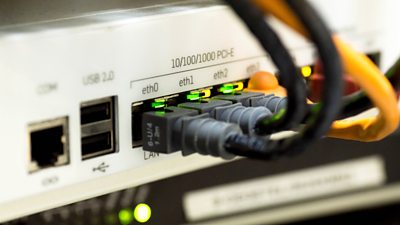If you get into the car, packed up for your holiday, drive off the ferry and down through continental Europe, you expect to be able to listen to the radio as you travel - whichever receiver you have. If you buy any television from your local shop, you expect to be able to take it home, plug it in and work – you can watch any available channel that you’ve paid for. We all take for granted; that any service can be received on any device.

This didn’t just happen by magic. There are thousands of engineers and technologists working behind the scenes to develop and agree the technology standards that make this interoperability possible. For 91�ȱ� R&D, being a key part of, and often leading the various consortiums, collaborative projects and associations groups responsible for such .
Almost all of these standards are developed with international partners, and this trend is only increasing. Standards need to be international to scale and generate economically viable markets. Even standards which are aimed at only the UK market are developed with international partners as they will be involved in making part of the equipment or supporting them in the future.
As I said, the 91�ȱ�, specifically . We have had a history of being involved in the development of standards for broadcast technology. One standard can lead to equipment all the way through the chain, from the camera or microphone right to the equipment in your home, car or mobile. We currently work in approximately 40 different groups and sub-groups, to varying extents. In fact, for some projects, standards are the result of our work: we spend a long time in proposing, discussing and testing the standards before they published and the kit goes on sale.
Systems are now generally too complex and expensive for one organisation to develop alone. Most standards bodies have tens if not hundreds of organisations as members. They will have come from different perspectives and will bring varied view points and expertise. These build up to a powerful working group. Normally, like in any project, smaller groups will develop each part of the jigsaw, and then the whole thing will come together under one steering board.
There are a vast range of companies and organisations we work with: large, small, academic, industrial, regulatory. For all, the main concern is that there should be similar aim to have widespread standards and that we can work together to come to a common approach. Sometimes this will lead to compromise – so there needs to be a mutual understanding of where business and operational requirements may lead to different optimal versions.
by part of the agreement with the Government that supports the 91�ȱ�'s Charter – this is a clause that we have always been very keen to see included as it is very much part of our DNA. There are a number of other reasons why we think that standards are a good thing, not only for the 91�ȱ� but the rest of the industry - what are they?

We want to gain industry leadership and influence, providing the systems and tools that will enable us to create innovative new services, content & functionality. We licence our technology used in standards according to commercial terms of the particular standards group. These are frequently on fair, reasonable and non-discriminatory terms, in a way to make them attractive for use.
At the same time it is important that we build industry consensus and support for our ideas as well as backing the ideas of our partners to try to build the best solutions balancing cost, functionality and user experience.
We want to promote open, interoperable platforms for producing, delivering and consuming digital content. Platforms are generally the most successful in the long term when they provide access to lots of content and open platforms are attractive to content providers.
We want to avoid costs in distribution by reducing the number of disparate platforms we deliver to. This means that we can give access for the greatest number of our licence fee payers without increasing our distribution costs and so having more money to put into programmes.
We want to guarantee end-to-end levels of performance and interoperability and standards can help us to do so.
We want to maximise the quality of services & experience – this helps ensure audiences experience our content and services as we intend them to. In particular, we have placed a strong emphasis on standards for access services such as subtitles and audio description for broadcast and streamed services.
We want an open marketplace for equipment - drive down costs and increase choice of suppliers for 91�ȱ� and consumers.

To give you a tangible idea of some of the standards we have helped develop and agree in the past, here are a few of the highlights:
Television
We were involved in both the main standards set in Europe and the guidelines for use in Freeview:
- DVB-T - the technology that enabled UK licence fee payers to receive digital TV through an aerial, used in Europe and across the world.
- DVB-T2 – the technology that enabled UK licence fee payers to receive HD on Freeview.
- Standards for the information that helps you to .
- Standards for .
Radio
- RDS - information that identifies the FM radio station that you are listening to so that radios can keep you tuned the station as you move and show what it is on a screen.
- DAB – the digital radio service used in the UK and being rolled out across Europe.
Production Standards
We are involved in a large number of standards which are looking to change the technology used in making programmes and preparing to send them out from using dedicated cables and standards to the use of . This will make it cheaper to install and more flexible to change. This is over a wide range of standards bodies, including:
- AMWA (Advanced Media Workflow) – standards for networked media, including workflows for editing, repurposing and archiving, driven by the needs of businesses working in these areas and ensuring that they are tested.
- - takes standards developed in AMWA and other groups such as SMPTE and helps them to be deployed
Software
At the 91�ȱ� we believe that it is important not only to propose standards, but to test and build to the standards. This used to be making hardware, for instance for the DVB-T transmitters and receivers. . Some bodies expect you to have working code before you submit it to a standard with the intention of improving the results. We fully support this approach, to make the standards usable and realistic.

As standards become more complex, they will only succeed if there are contributors from across the media industry in all parts of the business chain. Whilst 91�ȱ� R&D can do our best to take the viewpoint of other broadcasters, content providers, equipment manufacturers and consumers, it is important that representative from all these areas take part to ensure they are represented.
We all benefit from standards – so let’s all put in our efforts to make them as good as possible.
- -
